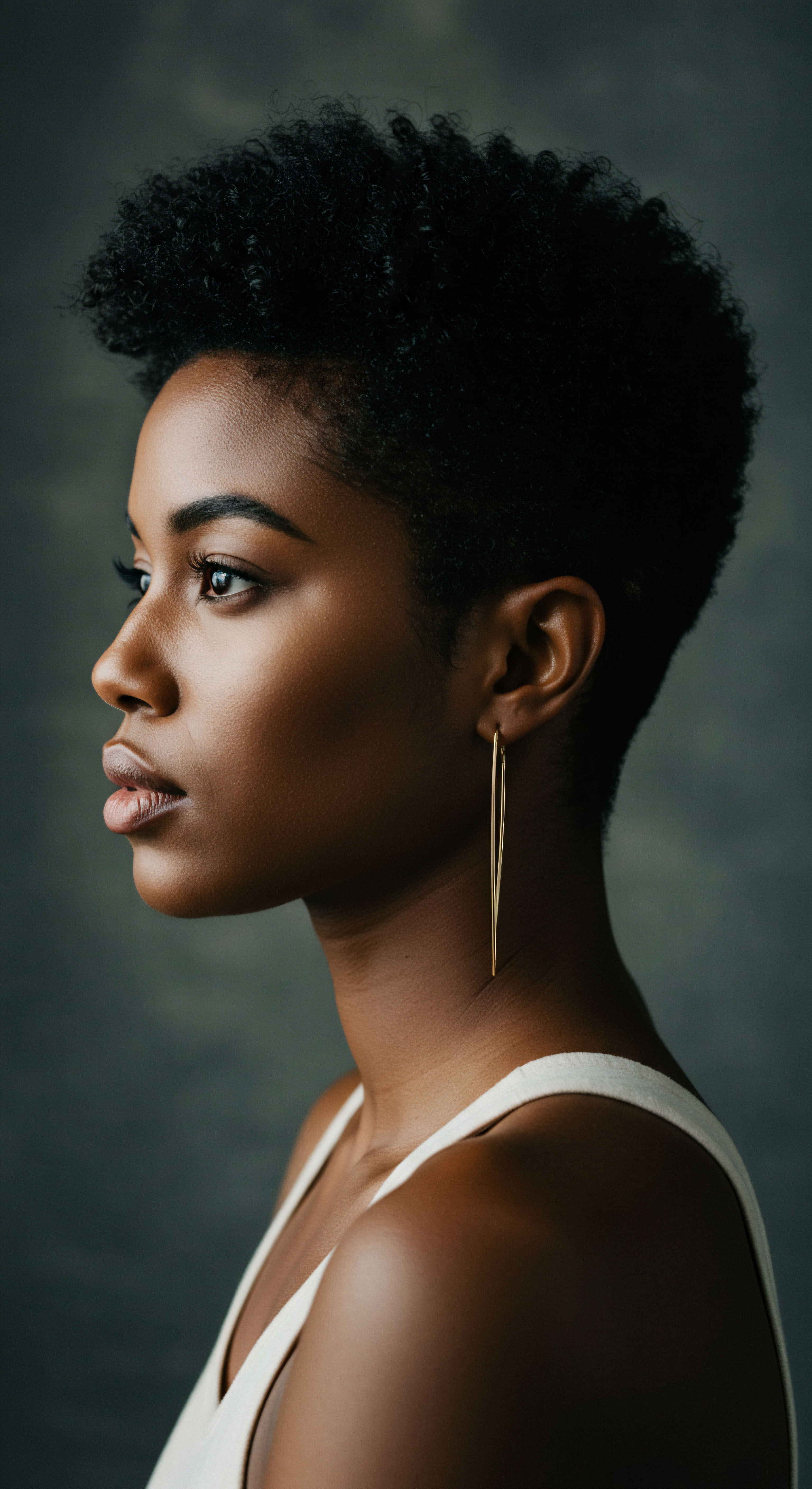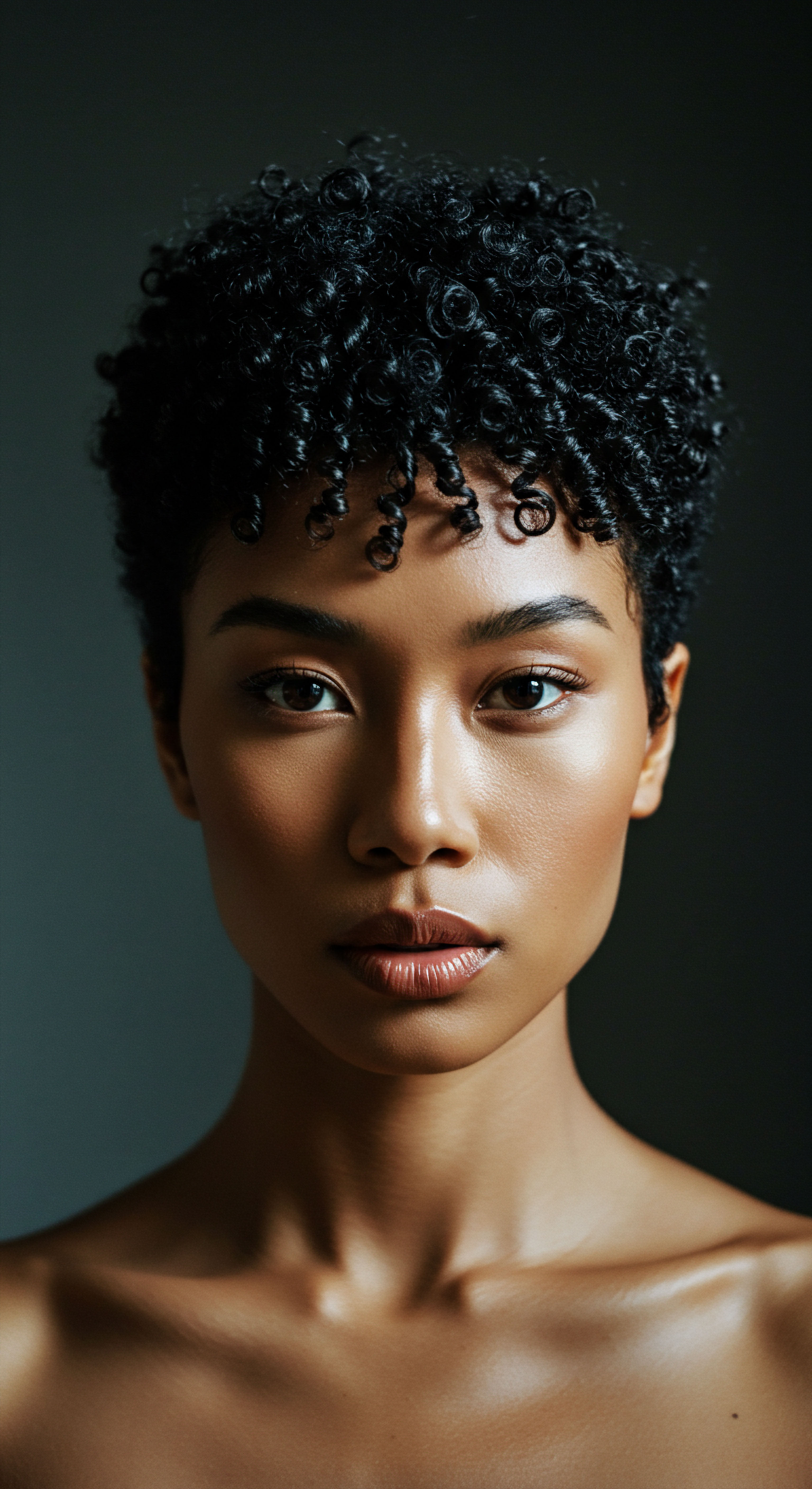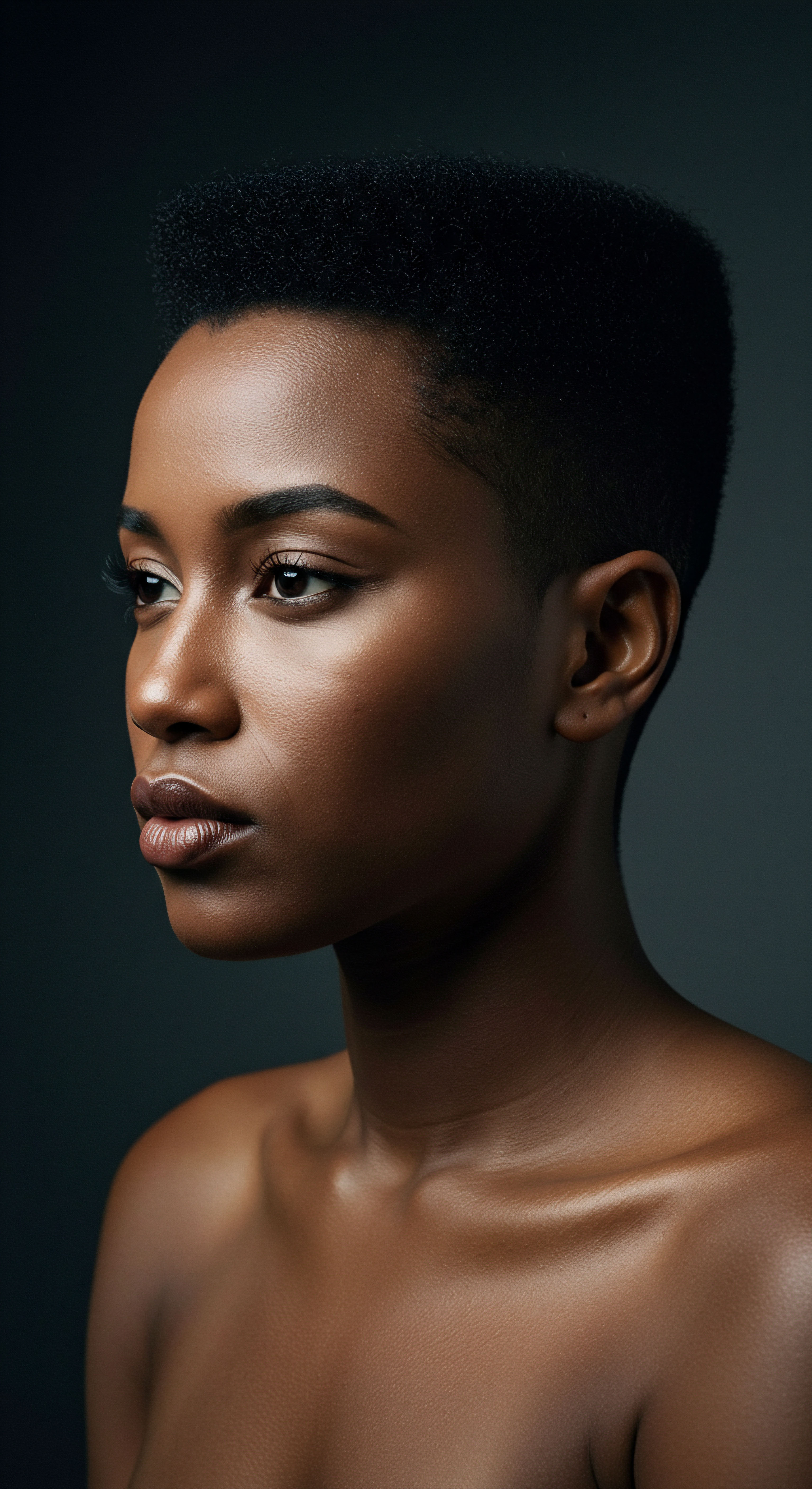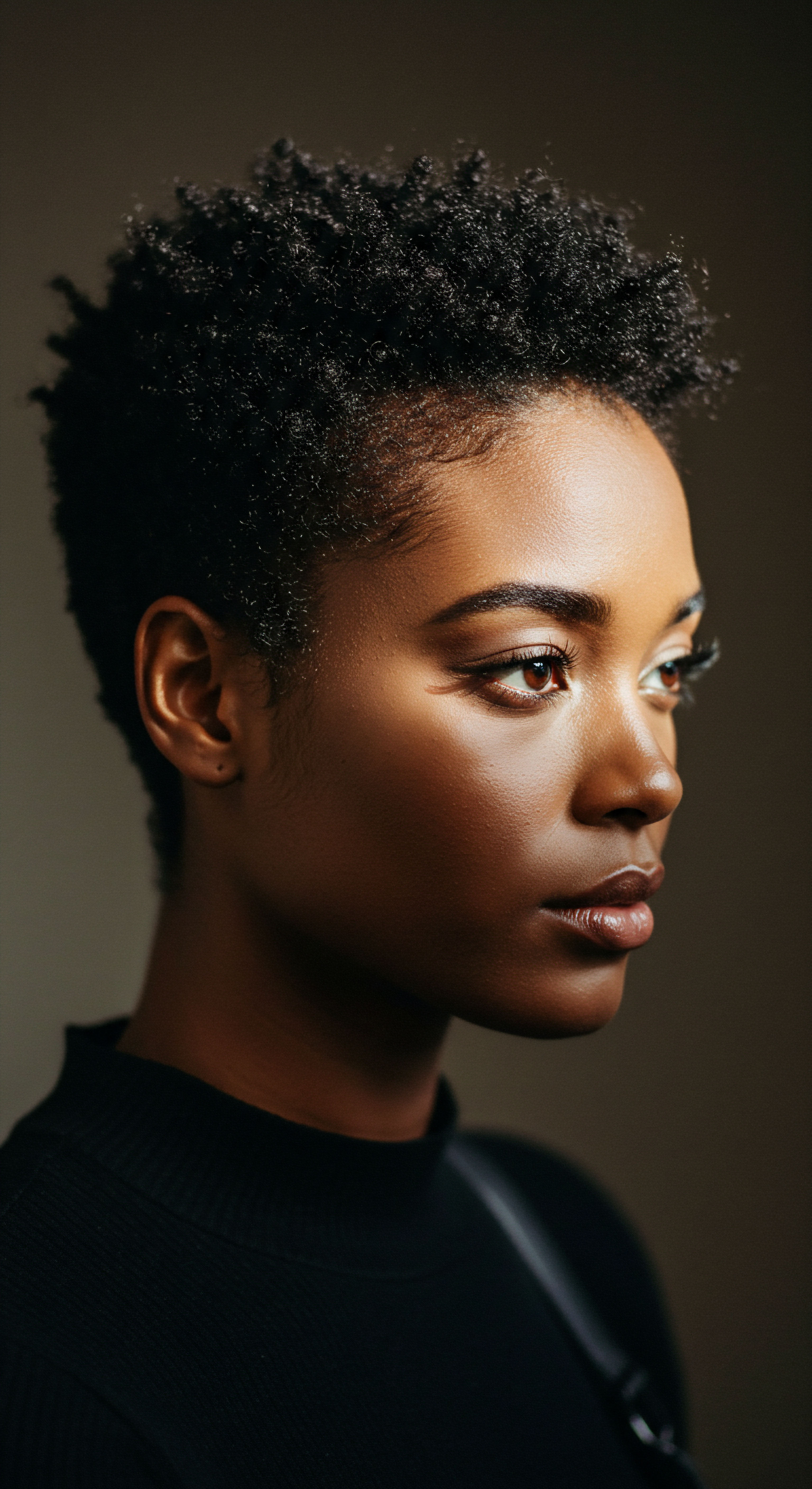
Roots
The whisper of antiquity often carries with it a longing to comprehend the daily rhythms and intimate customs of those who walked before us. Among these echoes, the care given to one’s physical presentation stands out, particularly the elaborate arrangements of hair in ancient Egypt. It is a topic that invites a gentle curiosity, prompting us to consider the profound connection between personal adornment and the very essence of being, even when hidden beneath layers of elaborate wigs. The dry, warm winds of the Nile Valley, though distant in time, stir questions about how the people of that vibrant civilization maintained their natural strands, a practice often overlooked in the dazzling display of their iconic head coverings.
Ancient Egyptian society, with its deeply stratified structure, held hair in high regard, viewing it as a symbol of status, hygiene, and even spiritual connection. Far from a mere accessory, hair was an integral part of personal identity, and its treatment reflected both practical considerations and profound cultural beliefs. While the grandeur of wigs, often seen in tomb paintings and surviving artifacts, might suggest a complete dismissal of natural hair, the truth is far more nuanced.
The underlying scalp and hair received meticulous attention, driven by a desire for cleanliness, comfort, and the perpetuation of beauty beyond earthly existence. This dual focus on both the natural and the artificial speaks volumes about their comprehensive approach to self-care.

Hair Anatomy and Physiology Specific to Textured Hair in Ancient Egypt
When we consider the hair of ancient Egyptians, it is essential to acknowledge the diversity of hair textures that would have existed within the population. While modern categorizations may not perfectly align, evidence suggests a prevalence of hair types that would today be described as textured—ranging from wavy to tightly coiled. The anatomical structure of these hair types, with their elliptical cross-sections and varying cuticle patterns, presents unique challenges and requirements for care.
In the hot, arid climate of Egypt, maintaining moisture and preventing breakage would have been paramount. The natural curvature of textured hair, often prone to dryness due to the open nature of its cuticle layers, necessitated external lubrication and protective measures.
The scalp, too, demanded particular consideration. Beneath the sun’s relentless gaze and often covered by heavy wigs, the skin needed to breathe and remain free from irritation. The sebaceous glands, responsible for producing the natural oils that condition hair, would have been active, but the dry air could quickly strip away this protective layer. Thus, the application of external emollients became a crucial step in their hair care regimen, a practice that echoes through centuries into contemporary textured hair care philosophies.
Ancient Egyptians valued hair as a symbol of status and hygiene, meticulously caring for natural strands even when hidden beneath elaborate wigs.

Understanding Ancient Hair Classification
The ancient Egyptians did not classify hair in the scientific manner we do today, yet their practices reveal an intuitive comprehension of different hair needs. Their wigs themselves were crafted from various materials, reflecting both social standing and the desired aesthetic. The most prized wigs were fashioned from human hair, often plaited into hundreds of individual strands and secured with natural fixatives.
Less affluent individuals might use wigs made from vegetable fibers, wool, or even horsehair. This variation in wig material hints at an understanding of how different substances interacted with the natural scalp and how they contributed to the overall look and feel.
The way hair was prepared for wig placement also speaks to a form of “classification” through practical application. Some individuals shaved their heads completely, particularly priests, to maintain ritual purity and prevent lice infestations. Others kept their hair cropped short, providing a clean base.
Still others, as evidenced by archaeological finds, maintained their natural hair, styling it in ways that allowed it to be worn beneath or even integrated with hair extensions and partial wigs. This adaptability suggests a recognition of individual hair characteristics and how they could be managed within the prevailing beauty standards.
- Human Hair Wigs ❉ The most expensive and sought-after, often intricately braided and styled.
- Animal Hair Wigs ❉ Including sheep’s wool or horsehair, offering alternatives for those of lesser means.
- Plant Fiber Wigs ❉ The most affordable option, made from materials like papyrus, used by common people.

The Essential Lexicon of Ancient Egyptian Hair Adornment
To truly appreciate ancient Egyptian hair care, one must grasp the vocabulary of their cosmetic world. Beyond the ubiquitous “wig,” a variety of terms and concepts describe their approach to hair. The Greek historian Herodotus noted the Egyptians’ meticulous hygiene, including the removal of facial and body hair. This practice of hair removal extended to the head for many, paving the way for wig-wearing.
Terms like “unguent” and “oil” appear repeatedly in historical texts and archaeological analyses, pointing to the widespread use of fatty substances for conditioning and styling. These were not simply cosmetic; they served a protective role against the harsh sun and dry climate. The concept of “ritual purity” also deeply influenced hair practices, especially for priests who shaved their heads to avoid anything that might interfere with their sacred duties, such as lice. The very act of preparing the hair, whether for life or for the afterlife, carried significant cultural weight.

Hair Growth Cycles and Influencing Factors in Ancient Egypt
The fundamental biological processes of hair growth would have been the same for ancient Egyptians as they are for us today. Hair cycles through growth (anagen), resting (catagen), and shedding (telogen) phases. However, various factors unique to their environment and lifestyle would have influenced these cycles and overall hair health. The diet, primarily composed of grains, vegetables, and some meat, provided the necessary nutrients, though nutritional deficiencies could still occur.
The constant exposure to the desert environment, with its intense sun and dry air, would have been a significant external stressor. While wigs offered protection, the underlying hair still needed resilience. Evidence from ancient texts suggests a concern for hair loss and graying, with remedies documented in papyri like the Ebers Papyrus, though their effectiveness is debated. This indicates a conscious effort to maintain hair health and appearance throughout life, not merely to cover it with a wig.
The discovery of a fat-based hair gel used to set styles, found on mummies dating back 3,500 years, further highlights their dedication to hair maintenance and aesthetics, even in death. This styling product, containing long-chain fatty acids like palmitic and stearic acid, was applied to both natural and artificially mummified hair, suggesting its use was both for daily life and for preserving appearance for eternity.

Ritual
To peer into the daily practices of ancient Egyptians regarding their hair, especially when considering the widespread custom of wig-wearing, is to step into a realm where personal care intertwined with societal expectation and environmental adaptation. It is a quiet unfolding of routines, a thoughtful application of ancient wisdom to the practicalities of maintaining well-being beneath elaborate external adornments. The preparation of the scalp and natural hair for the placement of a wig was a deliberate and often luxurious act, far from a simple concealment. It reflected a deep understanding of what was required to preserve hair health in a challenging climate while upholding the standards of beauty and cleanliness.
The choice to wear a wig was multifaceted, driven by factors such as hygiene, social standing, and protection from the sun. Yet, this choice did not negate the need for internal care. The underlying hair, whether closely cropped or left longer, required regular cleansing and conditioning. The archaeological record, alongside textual evidence, offers glimpses into these routines, revealing a sophisticated approach to personal grooming that belies the apparent simplicity of simply donning a wig.

Protective Styling Principles of Ancient Egypt
The very act of wearing a wig in ancient Egypt can be viewed as an early form of protective styling. Wigs shielded the natural hair and scalp from the intense sun, preventing damage and excessive moisture loss. They also served a crucial hygienic purpose, helping to deter lice infestations, a common concern in ancient times. For those who opted to keep their natural hair, even when wearing a wig over it, techniques existed to minimize friction and promote scalp health.
While direct evidence of specific protective styles worn under wigs is limited, the practices of braiding and plaiting human hair for wig construction suggest these techniques were well understood. It is plausible that natural hair was kept in simple, secured styles—perhaps small braids or twists—to lie flat and comfortably beneath the wig cap, minimizing tangling and making periodic cleansing easier. This would have created a barrier, a layer of protection, between the natural hair and the often heavy, resin-set wigs.
Ancient Egyptians saw wig-wearing as a form of protective styling, shielding natural hair from sun and lice, while maintaining underlying scalp health.

Natural Hair Definition and Care Under Wigs
Even with wigs as the dominant fashion, the natural hair beneath was not forgotten. Its condition was paramount, particularly for the elite who could afford dedicated attendants for their grooming. The dry conditions of Egypt allowed for the natural preservation of hair on mummies, offering direct evidence of ancient hair treatments.
Analysis of hair samples from mummified remains, some dating back 3,500 years, revealed the application of a fat-based substance. This substance, composed of long-chain fatty acids, served as a styling product to hold hair in place, but also likely acted as a conditioner, providing moisture and a protective barrier.
Ancient Egyptians utilized a variety of natural ingredients for their hair and skin care. Oils and fats derived from plants and animals were commonly applied. These emollients would have been massaged into the scalp and hair, helping to moisturize, add sheen, and potentially deter pests.
Henna, a plant-based dye, was also used not only for coloring hair, often to conceal gray strands, but also for its conditioning properties. Ramesses II, for example, had henna-dyed hair, which may have been applied posthumously to restore a youthful appearance.
The consistent application of such products would have contributed to the health and manageability of the natural hair, making it more comfortable to wear beneath wigs for extended periods. This continuous conditioning would have been essential to counteract the drying effects of the environment and the potential friction from wig caps.

Wigs and Hair Extensions Mastery for Scalp Comfort
The construction of ancient Egyptian wigs was a sophisticated art, with wigmakers skillfully braiding human hair into hundreds of tiny plaits, often secured with beeswax and resin on a mesh cap. The goal was not just external beauty, but also a comfortable fit that would allow the natural scalp to breathe. A wig’s mesh-like foundation base allowed body heat to escape, a practical consideration in the hot climate.
Beyond full wigs, Egyptians also used hair extensions, attaching false plaits directly to their natural hair. This practice suggests a desire to augment existing hair while maintaining its base. The adhesive used, often a mixture of beeswax and resin, would have been applied carefully to avoid excessive buildup on the natural hair and scalp. Regular cleansing and conditioning would have been necessary to remove residues and maintain scalp health.
The value placed on wigs is evident in archaeological finds; an accounts list from the town of Kahun placed hair’s value in the same category as gold. This economic significance underscores the meticulous care invested in their creation and, by extension, the care of the natural hair that served as their foundation.

Ancient Hair Tools for Under-Wig Care
A collection of grooming tools accompanied the ancient Egyptians’ hair care rituals. Combs, some of the oldest hair accessories discovered, were made from materials like ivory, bone, and wood, often with fine and wide teeth. These combs were not only for styling wigs but also for detangling and cleansing natural hair. The dual-sided nature of some combs, with fine teeth on one end and wider teeth on the other, suggests their versatility for different hair needs, from detangling to removing impurities.
Other tools, such as tweezers and razors made of stone or bronze, were used for hair removal, a common practice for hygiene and aesthetic reasons. While primarily for body hair, these tools might have been used to maintain a closely shaved scalp for those who preferred complete hair removal under their wigs. The existence of metal implements resembling curling tongs also points to a desire for styled natural hair, even if it was eventually covered.
| Tool Combs |
| Material Ivory, Bone, Wood |
| Primary Use Detangling, cleansing, scalp stimulation, removing impurities. |
| Tool Razors/Tweezers |
| Material Stone, Bronze, Copper |
| Primary Use Hair removal (scalp, facial, body hair) for hygiene and aesthetics. |
| Tool Curling Tongs |
| Material Metal |
| Primary Use Styling natural hair with curls, even if covered by wigs. |
| Tool These tools facilitated both the preparation of natural hair and the maintenance of wigs. |

The Nighttime Sanctuary for Hair and Scalp
While specific textual evidence detailing nighttime hair routines under wigs is scarce, the general emphasis on hygiene and preservation suggests that nighttime would have been a crucial period for scalp and hair care. Removing wigs at night would have allowed the scalp to breathe and prevented excessive sweating, which could lead to irritation or infections.
After removing the wig, the natural hair and scalp could be cleansed, massaged with oils, or treated with various unguents. These nighttime rituals would have promoted blood circulation to the scalp, conditioned the hair, and prepared it for another day of being covered. The dry climate would have necessitated regular moisture replenishment, making overnight oiling a logical practice. The concept of using head coverings, such as linen cloths, at night to protect treated hair or to absorb excess oils is a reasonable inference, aligning with their meticulous approach to personal care.

Relay
As we move beyond the surface of ancient Egyptian hair practices, a deeper inquiry reveals not just methods of care, but a profound intersection of science, culture, and individual well-being. The simple question of how ancient Egyptians cared for their hair beneath their wigs expands into a complex exploration of human ingenuity, environmental adaptation, and the enduring human desire for beauty and health. It compels us to consider the subtle dynamics between what was seen and what was hidden, between societal demands and personal comfort. This layered understanding allows us to appreciate the true sophistication of their approach, which extended far beyond mere aesthetics into the realms of health, social signaling, and even the afterlife.
The archaeological record, illuminated by modern scientific analysis, provides an invaluable window into these hidden practices. The preservation of mummified remains, often with hair remarkably intact, offers tangible proof of the substances and techniques employed. This tangible evidence, when combined with artistic depictions and ancient texts, allows us to piece together a comprehensive picture that challenges simplistic assumptions about wig-wearing as a complete abandonment of natural hair.

The Scientific Analysis of Ancient Hair Preserved
Modern scientific methods have provided unparalleled insights into ancient Egyptian hair care. Analysis of mummified hair samples, using techniques such as gas chromatography-mass spectrometry, has revealed the precise chemical composition of the substances they applied. A notable study examined hair from 18 mummies, some dating back 3,500 years, and found a fat-based coating on nine of them.
This coating consisted of biological long-chain fatty acids, including palmitic acid and stearic acid. The presence of this substance on both naturally preserved and artificially mummified hair suggests it was a regular beauty product used during life, not just for embalming.
This finding is particularly compelling because it indicates a deliberate and effective approach to conditioning. Fatty acids are emollients, providing moisture and a protective barrier, which would have been vital in the arid Egyptian climate. The researchers speculated that this fat-based “gel” was used to set hairstyles, but its conditioning properties would have simultaneously benefited the underlying natural hair, preventing dryness and breakage. This challenges the notion that natural hair under wigs was neglected; rather, it suggests it was actively nourished.
Scientific analysis of ancient Egyptian mummified hair reveals a fat-based coating, suggesting regular conditioning and styling beneath wigs.

Cultural and Social Implications of Hair Care Under Wigs
The decision to shave one’s head or keep hair cropped beneath a wig was deeply embedded in ancient Egyptian social and religious structures. For priests, a shaved head was a mark of ritual purity, preventing lice that could compromise their sacred duties. This practical hygiene merged seamlessly with spiritual tenets.
For the broader elite, wigs served as a clear marker of social standing and wealth. The most elaborate wigs, often made of human hair and meticulously styled, were a luxury item.
The maintenance of natural hair, even if hidden, played a subtle yet significant social role. A healthy scalp and well-conditioned hair would have contributed to overall comfort and well-being, allowing individuals to wear their often heavy and elaborate wigs for extended periods. This commitment to underlying care, even when not visible, speaks to a holistic approach to personal presentation where internal comfort supported external display. The concept of “eternal hairdo,” as some researchers describe the care given to hair for mummification, highlights the belief that physical perfection, including hair, was important for the afterlife.

Hair as a Symbol of Identity and Status
Hair in ancient Egypt was more than just a physical attribute; it was a potent symbol of identity, social standing, and even religious belief. The presence or absence of hair, and the style it took, conveyed messages about an individual’s place in society.
- Elite Status ❉ Elaborate wigs, particularly those crafted from human hair, were a clear sign of wealth and high social rank. The sheer time and skill required to create such wigs made them inaccessible to the common populace.
- Hygiene and Purity ❉ Shaved heads, especially among priests, signified cleanliness and ritual purity, which was essential for their sacred roles. This practical consideration became intertwined with spiritual meaning.
- Protection from Elements ❉ Wigs provided a practical shield against the intense sun and heat, protecting the scalp from sunburn and minimizing sweating. This dual function of aesthetic and utility was central to their adoption.

The Health Ramifications of Wig Wearing and Underlying Hair
While wigs offered benefits like sun protection and lice deterrence, wearing them for extended periods, especially heavy ones secured with resins and beeswax, could pose challenges to scalp health. The natural hair beneath would have experienced reduced air circulation, potentially leading to sweat accumulation and irritation. This underscores the necessity of regular and thorough cleansing routines for the natural hair and scalp.
The discovery of fat-based hair gels, containing substances like palmitic and stearic acid, on mummified hair is telling. These compounds, similar to modern conditioners and pomades, would have helped to lubricate the hair shaft and scalp, minimizing friction from the wig and preventing dryness. This proactive conditioning would have been essential to maintain hair integrity and scalp comfort. Without such care, prolonged wig use could lead to issues like traction alopecia or fungal infections, particularly in a warm, humid environment (even if generally arid, localized humidity could occur under a wig).
A fascinating study by McCreesh et al. (2011) published in the Journal of Archaeological Science provides direct evidence of a fat-based product used on ancient Egyptian hair. The study, analyzing hair from 18 mummies, found that nine had hair coated in a substance containing biological long-chain fatty acids. This application, they posited, served to keep hairstyles in place in both life and death.
The researchers further noted that the product was found on both male and female mummies, across different ages, suggesting a widespread practice of using this fatty substance. This unique insight from direct chemical analysis of human remains offers compelling evidence of intentional hair care beyond mere aesthetic styling.

Ancient Hair Dyes and Treatments
Beyond conditioning, ancient Egyptians also used various treatments to alter their natural hair’s appearance. Henna, derived from the plant Lawsonia inermis, was a widely used natural dye, imparting a reddish-brown hue. This was applied to hair to cover gray strands, suggesting a desire to maintain a youthful appearance. The use of henna was not only cosmetic but also carried spiritual significance, with red hair sometimes associated with the goddess Isis.
Other ingredients were employed for different color outcomes. For darker shades, recipes might include juniper berries kneaded into a paste with oil. While the effectiveness of some ancient remedies for hair growth or baldness, documented in papyri, remains questionable, their very existence points to a society deeply invested in the health and appearance of natural hair. These treatments, whether for color or perceived health benefits, demonstrate a sophisticated understanding of natural ingredients and their potential applications, even if the underlying scientific mechanisms were not fully understood.
The interplay between the natural hair and the wig was therefore one of careful management. The wig provided the desired public presentation and protection, while the natural hair beneath received attention to ensure its health, comfort, and sometimes, its color. This dual approach speaks to a practical and aesthetic sensibility that transcended the simple act of covering one’s head.

Reflection
The journey through ancient Egyptian hair care, particularly the practices beneath their celebrated wigs, invites us to consider the enduring human desire for both outward presentation and inner well-being. It is a subtle dance between the visible and the hidden, a testament to a civilization that understood the interconnectedness of beauty, hygiene, and social standing. The meticulous attention given to natural hair, even when concealed, speaks volumes about a deep respect for the body and a holistic approach to personal care.
It reminds us that true care extends beyond what meets the eye, reaching into the quiet spaces where comfort and health truly reside. The whispers of their routines echo into our present, inviting us to find balance in our own hair journeys, honoring both the strands we present to the world and the delicate roots that support them.

References
- Fletcher, J. (1995). Ancient Egyptian Hair ❉ A Study of its History, Biology and Anthropology. University of Manchester.
- Fletcher, J. (1999). Hair and the Ancient Egyptian. In A. Rosalie David (Ed.), Mysteries of Ancient Egypt. Routledge.
- Lucas, A. (1962). Ancient Egyptian Materials and Industries. Dover Publications.
- McCreesh, N. Gize, A. & David, R. (2011). Ancient Egyptian hair gel ❉ New insight into ancient Egyptian mummification procedures through chemical analysis. Journal of Archaeological Science, 38(11), 2931-2934.
- Pemberton, D. (2001). The Cleopatra Beauty Book ❉ Discover the Glamour Secrets of the Queens of Ancient Egypt. British Museum Press.
- Robins, G. (1993). Women in Ancient Egypt. British Museum Press.
- Tyldesley, J. (2002). Daughters of Isis ❉ Women of Ancient Egypt. Penguin Books.
- Valdesogo, M. R. (2012). Hair and Death ❉ A Study of Hair in Ancient Egypt. Unpublished Doctoral Thesis, University of Manchester.
- Walter, P. et al. (1999). Making make-up in Ancient Egypt. Nature, 397(6720), 483-484.